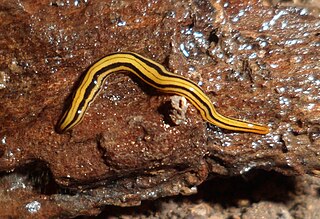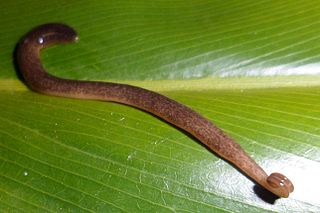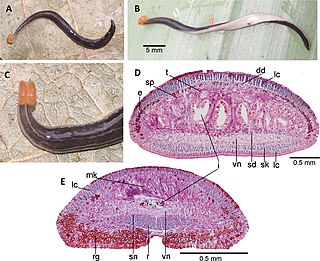
Geoplaninae is a subfamily of land planarians endemic to the Neotropical region. Members of this family are sometimes referred to as the Neotropical land planarians. However, one species, Obama nungara has been introduced in Europe.

Luteostriata is a genus of land planarians from Brazil characterized by a yellow body with dark longitudinal stripes.

Obama is a genus of land planarians from South America. It contains several species adapted to human-disturbed environments, including the only invasive land planarian native to the Neotropical realm, Obama nungara, which has been accidentally introduced in Europe.

The reproductive system of planarians is broadly similar among different families, although the associated structures can vary in complexity.

Choeradoplana is a genus of land planarians found in South America.

Cratera is a genus of land planarians found in South America.

Barreirana is a genus of land planarians from Brazil, formerly considered a subgenus of Geoplana.

Obama nungara is a species of land planarian in the family Geoplanidae. It is native to South America, but has been introduced in Europe.

Imbira guaiana is a species of land planarian in the subfamily Geoplaninae. It is the type species of the genus Imbira and is found in Brazil.
Choeradoplana agua is a species of land planarian belonging to the subfamily Geoplaninae. It is known from specimens found in Desengano State Park in Brazil.
Choeradoplana pucupucu is a species of land planarian belonging to the subfamily Geoplaninae. It is found in areas within the Atlantic Forest in Brazil, such as Serra da Bocaina National Park and in municipalities such as Teresópolis, São José do Barreiro, Salesópolis, and Ribeirão Pires.

Choeradoplana eudoxiae is a species of land planarian belonging to the subfamily Geoplaninae. It is known from specimens found in the São Francisco de Paula National Forest in Brazil.

Choeradoplana claudioi is a species of land planarian belonging to the subfamily Geoplaninae. It is known from specimens found in the Augusto Ruschi Biological Reserve in Brazil.

Choeradoplana onae is a species of land planarian belonging to the subfamily Geoplaninae. It is known from specimens found in the Augusto Ruschi Biological Reserve in Brazil.

Choeradoplana riutortae is a species of land planarian belonging to the subfamily Geoplaninae. It is known from specimens found in Serra dos Órgãos National Park in Brazil.
Cratera assu is a species of land planarian belonging to the subfamily Geoplaninae. It is known from specimens found in Serra da Bocaina National Park in Brazil.
Cratera boja is a species of land planarian belonging to the subfamily Geoplaninae. It is known from specimens found in Serra da Bocaina National Park in Brazil.
Cratera tui is a species of land planarian belonging to the subfamily Geoplaninae. It is found in Serra da Bocaina National Park and Itatiaia National Park in Brazil.
Cratera imbiri is a species of land planarian belonging to the subfamily Geoplaninae. It is known from specimens found in Campos do Jordão State Park in Brazil.
Cratera paraitinga is a species of land planarian belonging to the subfamily Geoplaninae. It is known from specimens found in the Boracéia Biological Station in Brazil.












